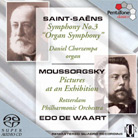December 2003
Good as that disc is, with its awesome organ-pedal notes in the second movement, this Rotterdam performance is a better one. The music seems to flow just a tiny bit faster and there is a lighter, breezier approach that makes the piece sound more appropriately Gallic. The orchestra’s strings play with finesse and there is an overall sheen to the sound reminiscent of the Philadelphia Orchestra in its prime. The woodwind soloists all play their passages with absolute assurance, and the brass section is all one could want. The organ passages are well registered by Chorzempa. The descending-scale passage just before the final chords is easily heard here and makes quite an impact. The recording is, in an overused word, awesome. It does not have subterranean bass, but it has solid bass with amazing focus, and the overall balance among the different orchestra choirs and the organ is impeccable. The important four-hand piano passages come through just right, easily heard yet not spotlighted. The sound stage is wide, as is the stereo separation, in a perspective almost from the podium, at least from the first ten rows. Woodwinds sound appropriate behind the strings and brass solos, such as those in the last movement from the horn, sound behind the winds. The organ is perfectly balanced with the orchestra; it can be heard clearly, but it never overwhelms the ensemble. The surrounds are simply used to convey the hall resonance. PentaTone has stuck to its guns in not fussing around with the original quad tapes. From the results, it is evident that the original production team knew well what it was doing, and PentaTone has respected its artistic integrity. The Mussorgsky, in the popular orchestration by Maurice Ravel, was recorded two years before the Organ Symphony, and sounds just as splendid. De Waart leads a performance that reveals every detail of the score without impeding its flow. The recording team was just as on as the conductor. The percussion section, in particular, is well served. Some struck xylophone notes are exceptionally effective early in the work and the bass drum in the last two movements has incredible focus and power. This is a hybrid SACD and, as good as the CD and stereo SACD tracks sound, they are flat by comparison with the 4.0 version. How wonderful to have two such popular audiophile favorites together in performances and recordings that are nearly definitive. GO BACK TO: |
 Saint-SaŽns - Symphony
No. 3 in C Minor "Organ Symphony"/Moussorgsky-Ravel - Pictures at an
Exhibition
Saint-SaŽns - Symphony
No. 3 in C Minor "Organ Symphony"/Moussorgsky-Ravel - Pictures at an
Exhibition Edo de Waart made a number of distinguished recordings for Philips
in the 1970s, but he, and his superb Rotterdam Philharmonic, somehow never really caught
on with the public. His reputation and vinyls did attract enough attention that he left
Rotterdam to be music director of the San Francisco Symphony for a while. In fact, he
recorded the Saint-SaŽns again with that orchestra in full digital sound.
Edo de Waart made a number of distinguished recordings for Philips
in the 1970s, but he, and his superb Rotterdam Philharmonic, somehow never really caught
on with the public. His reputation and vinyls did attract enough attention that he left
Rotterdam to be music director of the San Francisco Symphony for a while. In fact, he
recorded the Saint-SaŽns again with that orchestra in full digital sound.